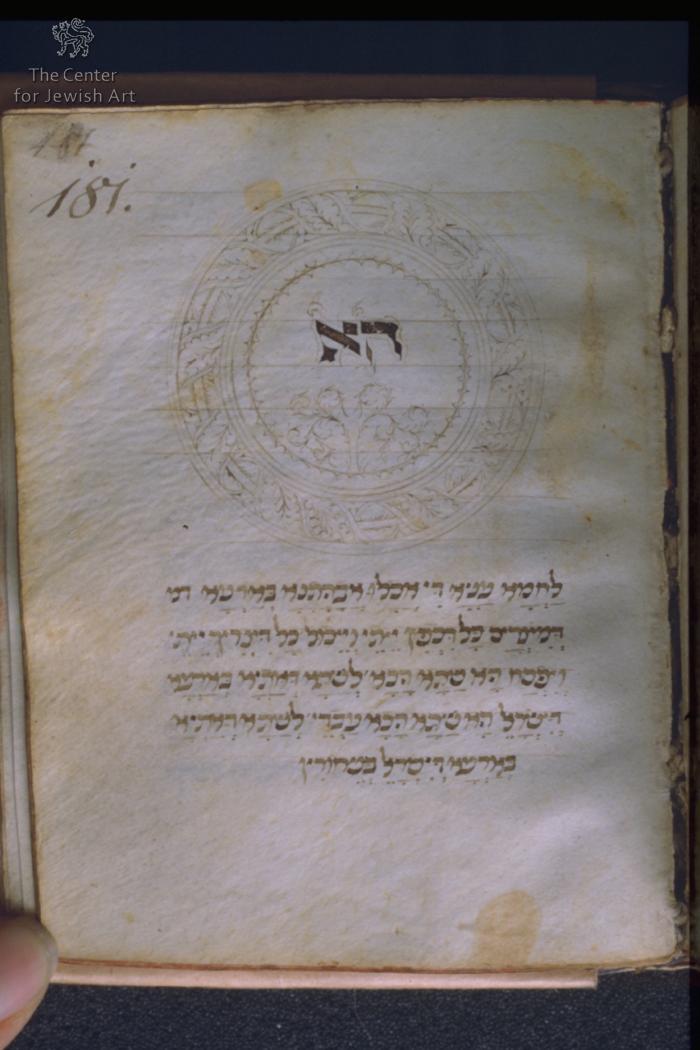Obj. ID: 1235
Hebrew Illuminated Manuscripts Vienna Woman's Siddur, Italy, Second half of the 15th century

The ViennaWoman's Siddur (Cod. Hebr. 86) is a tiny prayer book of Roman rite for weekly prayers with special additions for Festivals and High Holidays. It is evident that this prayer-book was intended for the use of a woman, as indicated by the first two in the preliminary morning service, ending with the formula: "…who did not made me a shifha (female slave)" (...שלא עשני שפחה); and "... who made me as He wished" (... שעשני כרצונו) on fol. 3v. Interesting to notice that the third blessing usually referring to gender שלא עשני גוי / שעשני ישראל, is totally missing in this manuscript. In other prayer-books of the Roman rite, produced in Italy apparently in the third and last quarter of the 15th century (see: Cohen, "Women's Prayer Books", pp. 305-312) one can find the same variants in the preliminary blessing. This indicates that the manuscripts, as well as Cod. Hebr. 86, were copied for a woman, as sometimes is also attested in the colophons, as for example in a Siddur copied by Abraham Farissol in 1471 or 1478 (New York, Jewish Theological Seminary Library, ms. 8255; here the scribe states he copied the manuscript for a male owner, whose name is erased, and his wife, who was the actual user of the Siddur, as also attested by the preliminary morning blessings on fol. 5v; see: Cohen, ibid., pp. 308-310).
Although the manuscript is lacking a colophon stating the date and place of production, the name Arieh is emphasized three times within the text (fols. 54v, 56v and 100v), and we believe it being the name of the scribe, whose hand is unknown from other manuscripts (the name Arieh is emphasized also in another Mahzor of Italian rite of the 15th century, yet the script is clearly different than that of the Vienna Woman's Siddur; see: Parma, Biblioteca Palatina, Parm. 2405, fol. 100).
The codicological features as well as the script of the Vienna Woman's Siddur are clearly of Italian type. Moreover, ruling by ink gives approximately the year 1427 as terminum post quem (see: Beit-Ariè, Hebrew Codicology, 1981, p. 78). The meager decoration program of the manuscript consists of only two pen-drawn text illustrations for two passages of the Haggadah, recurring in most Italo-Ashkenazi illuminated haggadot and prayer books from the 14th till the early 16th century. The first depiction, a round medallion reminding the seder plate enclosing the initial word "This [is the bread] (הא [לחמא]) (fol. 181), is actually less frequent, as usually this passage is illustrated with a depiction of the seder basked containing the three mazzot, raised by a group of people or simply by hands, as for example in a Mahzor of Roman rite, copied in Fermo in 1431, (formely: London, Jew's College, Montefiore Library, ms. 213, fol. 88; see comparison # 1; Narkiss, Italian Manuscripts;). The depiction in the Vienna manuscript with a large roundel looks more like the depiction of the large Mazzah within the text space of the text it illustrates, appearing in some Italian manuscripts, such as in the Bodleian Italian Mahzor (Oxford, Bodliean Lib. Mich. 610, fol. 94v; see comparison # 2; Narkiss, Italian Manuscripts, No. 49). In the Vienna Woman's Siddur the passage of "Mazzah" is not illustrated.
The second illustration depicts one hand with no arm holding a bunch of lettuce illustrating the passage of Maror (fol. 189). The representation of the Maror as a bunch of lettuce leafs recalls the analogous illustration in many other Italian manuscripts of the 15th century, in particular that in the "Rothschild-Weil Mahzor" (see: vol. I in Jerusalem, Jewish National and University Library, 8° 4450; fol. 120v – see: comparison # 3), dated around 1460-1470 (see: Metzger, "Un Mahzor"). Both manuscripts display the detail of the detached hand holding the bunch, whose wrist is decorated with a scalloped sleeve.
Both illustrations in our manuscript are executed in fine uncoloured pen-drawing, most possibly by the same hand, which is remaining unidentified. Possibly other decoration was intended to be added in the manuscript but never executed, as indicated by large space left empty around some initial words, such as for the first initial word "These" (אלו [מאה ברכות] ) on fol. 2v, and for the opening of the section for the Sabbath (fol. 64).
In conclusion, the Vienna Woman's Siddur was copied and decorated for a woman, in the second half of the 15th century in Central-Northern Italy.
sub-set tree:
Parchment, 199 + I (paper leaf pasted to fol. 199 and foliated fol. 200) leaves (see Qiures).
Measurements
|
Full page: (100-103) x (74-79) mm |
|
Text space: (67-70) x (43-48) mm |
Scribes
One single scribe: Arieh (who emphasizes his name on fols. 54v, 56v, 100v, see Scribal Notes)
Script
|
The main text is written in semi-cursive Italian script in brown ink |
|
The opening words for passages and new sections are in square Italo-Ashkenazi script |
|
Instructions written in semi-cursive Italo-Sephardic script in the same brown ink (e.g. fols. 43v, 51, 91, 91v, 129v, 160, 178-178v, 180v, 190-190v, 193) |
|
Confessions for Ne'ilah (fols. 156v-160) are written in square Italo-Ashkenazi script in large letters in brown ink |
Number of lines
|
The whole text |
14 lines per page (except for fols. 157–159v, which are 9 lines per page) |
Ruling
Ruling by ink on both sides, 14 horizontal lines and 1+1 vertical lines (except for fols. 161v-163v which are 1+2+2+1 and fol. 165 which is 1+1+1)
Pricking
No pricking is visible
Quires
20 quires of 10 leaves each, except for XX5+4 (fol. 200 is a paper leaf which was pasted to fol. 199 serving as the last leaf for this quire).
Catchwords
None
Hebrew numeration
None
Blank leaves
Fols. 1-2r (for recto)
The decoration was made in one stage probably by the scribe himself. It consists of pen-drawings in light brown ink in the same tonality as the script.
- Text illustrations: one within initial word panel, for "This [is the bread] (הא [לחמא]) (fol. 181); one in the margins, for maror (fol. 189).
- Decoration of descenders: small foliate flourishes extending from the legs of letters final nun (e.g. fols. 31, 139) or kof (e.g. fols. 15, 16, 20, 24, 67, 73, 91, 94v), when appearing on the last line of the page.




